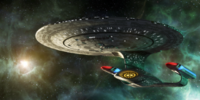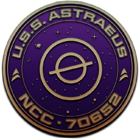Astraeus Refit Overview
| USS Astraeus | |||||||||||||
|---|---|---|---|---|---|---|---|---|---|---|---|---|---|
 ACTIVE STATUS | |||||||||||||
| |||||||||||||
ASTRAEUS REFIT OVERVIEW
Below is an overview of the differences between the Astraeus and a Galaxy class starship from the TNG or Deep Space 9 eras. Where not otherwise noted, her specifications and design are more or less identical to the Enterprise-D.
Hull, Defensive, and Warp Power Revisions
The neck connecting the Astraeus’ saucer and engineering sections was rebuilt into one that smoothed the transition between primary and secondary hulls, reinforcing a known weak point in the design. This resulted in the saucer being positioned further forward, increasing the ship’s overall length by seven meters.
The primary reason for this modification, however, was the installation of an experimental Quantum Slipstream drive. Designed before the discovery of such technology, integration into Galaxy class starships has always been a challenge, and Astraeus’ slipstream drive has proven too stressful on the spaceframe and power systems for practical use, as it requires the diversion of conventional warp power from engines to structural integrity fields. Because of this, procedure reserves slipstream use for emergencies, and travel to and from exploration regions that are too far to reach practically with her warp drive.
At nearly thirty years old, what had once been Starfleet’s fastest ship had been rendered one of its slower front line vessels by technical innovations utilized in new ship designs, such as the Sovereign and Intrepid classes. These modifications vastly increased the Astraeus’ optimum cruising speed from warp 6 to 8. In accordance to the warp scale restructuring of 2396, her emergency speed has increased from warp 9.2 to approximately warp 9.8 in the old scale, or warp 10 in the new. Her maximum velocity has been increased from warp 9.7 to warp 9.97 in the old scale, or warp 13 in the new. Her new warp configuration also worked as a solution for the problem of subspace pollution that had been originally solved in the Intrepid class’s variable geometry warp nacelles.
Internal / Scientific
Perhaps the most extensive refits were internal. Her three isolinear computer cores were replaced with top of the line bio-neural units one at a time, allowing the bio-neural replacements to absorb much of the system awareness that the isolinear units had developed over the last few decades. The Astraeus’ navigational deflector, already one of the most powerful and versatile in Starfleet, had its software and certain pieces of hardware upgraded and reinforced, increasing the ship’s sensor range and resolution, as well as her ability to emit and focus different types of energy and particles.
Additional scientific sections were added as well. Her diplomatic facilities were updated and diversified, to increase the variety of habitable conditions able to be offered to visiting dignitaries, and her recreational equipment was updated, providing as many luxuries to her crew on long-term voyages as possible.
Junior officers’ quarters generally consist of a living room, bathroom, and one or two bedrooms with comfortable and up to date furniture. Senior officers and the command staff are equipped with large suites whose size is dependent on whether they live with a family. Two to four bedrooms, a large living area, a den, a small office, and a small kitchenette upon request.
Tactical
Four phaser arrays were added, to the dorsal and lateral sides of the rebuilt warp nacelles, and multiple heavy duty fusion reactors were added throughout the ship to act as a secondary power source for these weapons, resulting in vastly increased phaser power. Her torpedo launchers were slightly modified to handle a load of quantum torpedoes rather than photon, and a second forward launcher was added to the forward section of the ship’s neck to better allow the ship to serve as heavy fire support in fleet engagements, a lesson learned during the Dominion war.
Her shield generator grid was upgraded, and additional fusion power generators were added to supplement the new shields, as well. Also, her structural integrity fields were reinforced and new RCS thrusters added across the Astraeus’ spaceframe, increasing her maneuverability. After a conflict alongside the USS Veritas in the Shoals, the decision was made to add ablative armor across her hull to protect her from extended attacks in the case of shield failure.
Borg Countermeasures
Several innovations theorized by the Enterprise-D during her engagements with the Borg in 2366 as well as further lessons learned in the Battle of Sector 001 and Voyager’s encounters through the Delta quadrant have been integrated into the Astraeus’ systems. Automatic phaser and quantum torpedo frequency modulation through the upper EM band and extremely rapid shield nutation, both accomplished at speeds driven by the vessel’s new bio-neural computer cores and impossible for her old isolinear circuitry, have been shown in simulations as being able to keep up with Borg adaptive technology for several minutes, hopefully giving the ship’s enhanced weaponry time to do some damage.
Summary, leading up to completion:
Such an extensive refit is not without its share of difficulties. Problems with acquiring and manufacturing materials normally used in new starship construction, such as ablative armor and bio-neural gel pack compatible computer cores, pushed the Astraeus’ refit behind schedule. Experts in Galaxy class systems were brought in to help keep the refit on track whenever possible, and completion followed by the beginning of a shakedown cruise eventually did follow.
With her refits complete, the Astraeus has been modernized into an almost entirely new vessel. Officers, crew, and department heads were required to recertify on her upgraded systems. She proved her worth in an extremely long distance exploration mission, one which saw the Federation make first contact with several new advanced species and explore a region of space charted only from great range before. The Astraeus is now considered a successful proof of concept for one type of modernized Galaxy class starship, despite the number of crew she requires to operate at high efficiency, and the increased maintenance time that must be spent by her Engineering and Operations staff in order to keep her in top condition due to her age and modifications.







